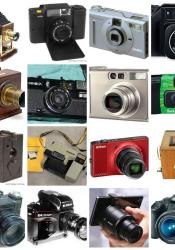Photography and the Camera
The type of photography that we are familiar with today began in late 1830's France. The first recorded permanent image was made by Joseph Niepce, who used a portable camera. Photography was only used by professionals, until George Eastman started the company Kodak in the 1880's. Eastman created a flexible roll film that did not require constantly changing the solid plates in a camera. This new change allowed him to develop a smaller self-contained box camera. The film during that time would be considered large compared to today's 35mm film. Film for 35mm would not be cheap enough for most consumers to use until the 1940's. Around the 1930's, Henri-Carter Bresson and other photographers began to use small 35mm cameras to capture images of life as it occurred rather than staged events. During the same time that the 35mm camera were popular, Polaroid introduced the Model 95. In the 1960's, this new camera was fairly expensive, but the public's attention was captured by the instant images that could be taken on this device. By 1991, the most basic point-and-shoot cameras could take high-quality printed photographs than Niepce's original model, and even now smartphones can now easily capture high-quality images.
This device serves as a tangible symbol of the progression of time in works such as, Livesey's 1950's set The Flight of Gemma Hardy , where the lost photograph of Gemma's uncle and mother was first mentioned (p. 40). The need to possess the photograph became a constant theme throughout the work, as it represented being connected with family, especially late family members. The importance of photography and cameras are persistent even in today's society. This can be seen in the 2013 YouTube series, The Autobiography of Jane Eyre, where Alysson Hall, who plays Jane Eyre, announces that, "I might catch up on my photography."(0:20, "Duck Pond", Ep: 8). These as well as Jane's past photos, were looked over by Rochester in "An Interview ?," episode 11, as a means to determine what type of person Jane is and what she sees in the world around her. This same examination of images was performed in Bronte's Jane Eyre, where Mr. Rochester scrutinized the images that Jane created, which during the early Victorian Era, were in the form of sketches and paintings (p.114, Norton 4th Critical Edition). Scenes like these not only reveal how present images/photography is to the characters, but it also indirectly serves as a time stamp that shows how imagery or photography was used in different time periods.
Bibliography
Bronte, Charlotte. Jane Eyre. W.W. Norton & Company Inc., 2016.
Hall, Alysson/Jane Eyre. The Autobiography of Jane Eyre. "Duck Pond-Ep: 8" Online video clip. YouTube. YouTube, 15 May 2013. Web. https://www.youtube.com/watch?v=GBnNrFhCCnI&list=PL3NxAiyc-89HP3wHV2y5mbwi2TidvocKZ&index=8
Livesey, Margot. The Flight of Gemma Hardy. HarperCollins, 2012.
Source of Information: Masoner, Liz. "A Brief History of Photography and the Camera." thesprucecrafts.com. The Spruce Crafts. 3 Jan. 2019. Web. Date Accessed, 9 Oct. 2019. https://www.thesprucecrafts.com/brief-history-of-photography-2688527
Source of Image: https://asiasmith4b.wordpress.com/2014/09/11/6/

